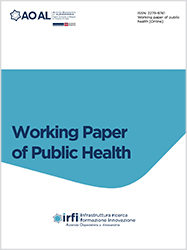Health determinants in the pediatric population: health education project on the correct use of digital technologies in adolescents

Accepted: 9 May 2022
All claims expressed in this article are solely those of the authors and do not necessarily represent those of their affiliated organizations, or those of the publisher, the editors and the reviewers. Any product that may be evaluated in this article or claim that may be made by its manufacturer is not guaranteed or endorsed by the publisher.
Contesto: Internet è un mondo di comunicazione in gran parte libera e di condivisione reciproca, ma rappresenta anche un rischio per la tutela della privacy e della riservatezza. È importante che gli operatori sanitari forniscano istruzione sull'uso corretto della tecnologia, creino programmi di supporto e stabiliscano la correlazione tra uso della tecnologia e dipendenza. L'obiettivo del progetto di educazione sanitaria è educare i bambini delle scuole secondarie all'uso responsabile delle tecnologie digitali.
Materiali e metodi: La formazione segue un programma di apprendimento misto, che combina diversi strumenti: e-learning; attività in aula con il docente di classe e il formatore del progetto; l'utilizzo di scenari, sia online che offline; e discussioni sui forum online.
Risultati: Lo sviluppo di un programma di formazione di sei moduli della durata di un anno scolastico.
Conclusioni: Un metodo di insegnamento innovativo che utilizza le tecnologie digitali può garantire un apprendimento personalizzato, autonomo e collaborativo: ogni allievo diventa il principale contributore della propria formazione.
Pew Research Center. Teens, Social Media and Technology 2018. [cited 2022 Jan 12]. Available at: https://www.pewresearch.org/internet/2018/05/31/teens-social-media-technology-2018/
We Are Social | Agenzia Creativa. We Are Social Italia. [cited 2022 Jan 12]. Available at: https://wearesocial.com/it/
Istat.it. [cited 2022 Jan 12]. Available at: https://www.istat.it/
Bagot KS, Milin R, Kaminer Y. Adolescent Initiation of Cannabis Use and Early-Onset Psychosis. Subst Abuse. 2015;36:524–33. DOI: https://doi.org/10.1080/08897077.2014.995332
Ferreira EZ, Oliveira AMN de, Medeiros SP, et al. Internet influence on the biopsychosocial health of adolescents: an integratitive review. Rev Bras Enferm. 2020;73:e20180766. DOI: https://doi.org/10.1590/0034-7167-2018-0766
Wong CA, Merchant RM, Moreno MA. Using social media to engage adolescents and young adults with their health. Healthc Amst Neth. 2014;2:220–4. DOI: https://doi.org/10.1016/j.hjdsi.2014.10.005
Eldik AK van, Kneer J, Lutkenhaus RO, Jansz J. Urban Influencers: An Analysis of Urban Identity in YouTube Content of Local Social Media Influencers in a Super-Diverse City. Front Psychol. 2019 [cited 2022 Jan 12];10. Available at: https://www.ncbi.nlm.nih.gov/labs/pmc/articles/PMC6930894/ DOI: https://doi.org/10.3389/fpsyg.2019.02876
Dienlin T, Johannes N. The impact of digital technology use on adolescent well-being. Dialogues Clin Neurosci. 2020;22:135. DOI: https://doi.org/10.31887/DCNS.2020.22.2/tdienlin
Yépez-Tito P, Ferragut M, Blanca MJ, et al. Sexting in adolescence: The use of technology and parental supervision. Rev Latinoam Psicol. 2020;52:115–30. DOI: https://doi.org/10.14349/rlp.2020.v52.12
Supporting Agencies
NonePAGEPress has chosen to apply the Creative Commons Attribution NonCommercial 4.0 International License (CC BY-NC 4.0) to all manuscripts to be published.

 https://doi.org/10.4081/wpph.2022.9494
https://doi.org/10.4081/wpph.2022.9494




